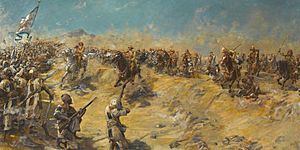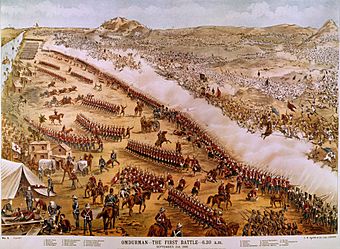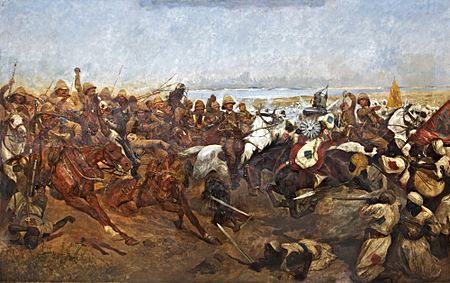Battle of Omdurman facts for kids
Quick facts for kids Battle of Omdurman |
|||||||
|---|---|---|---|---|---|---|---|
| Part of the Mahdist War | |||||||
 The Charge of the 21st Lancers by Edward Matthew Hale |
|||||||
|
|||||||
| Belligerents | |||||||
| Commanders and leaders | |||||||
|
|||||||
| Strength | |||||||
|
8,200 British, Total: 25,800 |
52,000 warriors | ||||||
| Casualties and losses | |||||||
| 47–48 dead 382 wounded |
12,000 killed 13,000 wounded 5,000 captured |
||||||
The Battle of Omdurman was a major fight during the Anglo-Egyptian conquest of Sudan. It happened on 2 September 1898, near Omdurman in Sudan. This battle was between a British and Egyptian army, led by British Commander Herbert Kitchener, and a Sudanese army. The Sudanese army was part of the Mahdist State, led by Abdullah al-Taashi.
The British government decided to send an army to Sudan to take control back from the Mahdist State. They also wanted to get revenge for General Gordon, who was killed when the Mahdist army captured Khartoum 13 years earlier. On the morning of 2 September, about 50,000 Sudanese warriors attacked the British lines. This attack was not successful. Later that morning, a British cavalry unit called the 21st Lancers made a famous charge.
The British and Egyptian forces won the battle. This victory showed how powerful a modern army with rifles, machine guns, and artillery could be. They defeated a much larger army that had older weapons. This battle was a big step in the British effort to take back Sudan.
Contents
Why the Battle Happened
British Control in Egypt and Sudan's Uprising
In 1882, the British took control of Egypt. Around the same time, a religious leader named Muhammad Ahmad appeared in Sudan. He called himself the Mahdi, which means "the Guided One." Thousands of Islamic warriors, known as the Ansār, followed him.
In 1883, an Egyptian army tried to stop the Mahdi's uprising but was defeated. Later, a British general named Charles George Gordon went to Khartoum. His troops were surrounded by the Mahdists. On 26 January 1885, the Mahdists attacked and killed all the soldiers defending Khartoum.
The Mahdist State and British Response
After the Mahdi died in 1885, Abdullah al-Taashi became the new ruler of the Mahdist State. This state was based on strict Islamic rules and used slavery. It created a difficult time for the people of Sudan.
In 1896, the British government decided to take back Sudan. They wanted to protect their interests, like the Suez Canal, and stop the slave trade. A British and Egyptian army, led by Major General Herbert Kitchener, marched south from Egypt.
Kitchener's army captured several important towns. They won a battle at the Atbara River in April 1898. This victory opened the way for them to move closer to Omdurman. By 1 September 1898, Kitchener's army, supported by powerful gunboats on the Nile River, was ready to face the main Mahdist army near Khartoum.
The Battle of Omdurman
Setting the Scene
The battle took place at Kerreri, about 11 kilometers (7 miles) north of Omdurman. Kitchener's army had about 8,000 British soldiers and 17,000 Sudanese and Egyptian troops. He arranged his army in a curve near the Nile River. Twelve gunboats were waiting on the river to help. The British and Egyptian cavalry (soldiers on horseback) were on the sides of the army.
Abdullah's army had about 50,000 warriors, including 3,000 cavalry. They were hidden in different groups. About 8,000 warriors were directly in front of the British. The rest were hidden behind hills, waiting to attack.
The Main Attack
The battle started early in the morning, around 6:00 a.m. About 8,000 Mahdist warriors charged directly at the British. Another 8,000 followed them. The British artillery (big guns) started firing from about 2,750 meters (1.7 miles away). This caused many casualties among the Mahdist forces before they even got close.
When the Mahdist forces came closer, the British Maxim guns and rifle fire opened up. The attack ended quickly. About 4,000 Mahdist warriors were killed, and none got closer than 50 meters (164 feet) to the British lines. Other Mahdist attacks on the sides were also stopped.
The Charge of the 21st Lancers
As the main British army moved forward, the 21st Lancers, a British cavalry regiment, was sent ahead. They were supposed to clear the plain near Omdurman. The 400 Lancers thought they would only face a few hundred enemy soldiers. However, 2,500 Mahdist infantry were hidden in a dip in the ground.
The Lancers charged into the hidden enemy. It was a very fierce fight. The Lancers managed to push the enemy back. This was one of the last big cavalry charges by British troops. A young soldier and reporter named Winston Churchill was part of this charge. Three Victoria Crosses, a very brave award, were given to Lancers who helped rescue wounded friends.
Later Attacks and Victory
After the charge, the Mahdist leader, Abdullah, reorganized his forces. He still had over 30,000 men. He ordered a new attack from the west and another from the northwest.
A British brigade of about 3,000 Sudanese soldiers, led by Hector MacDonald, was reinforced with Maxim guns and artillery. They faced a large attack of about 15,000 enemy troops. MacDonald's brigade fought hard and kept firing. Kitchener sent more support, and the Mahdist forces were eventually pushed back. They finally broke and ran, or died fighting.
The Mahdist forces from the north joined the fight too late. They also attacked MacDonald's brigades but were stopped by more British troops and heavy rifle fire. A final desperate charge by about 500 Mahdist horsemen was completely destroyed. The march on Omdurman continued around 11:30 a.m.
Awards for Bravery
![]() Four soldiers received the Victoria Cross for their extreme bravery during the battle on 2 September 1898:
Four soldiers received the Victoria Cross for their extreme bravery during the battle on 2 September 1898:
- Thomas Byrne, a Private in the 21st Lancers
- Raymond de Montmorency, a Lieutenant in the 21st Lancers
- Paul Aloysius Kenna, a Captain in the 21st Lancers
- Nevill Smyth, a Captain attached to the Egyptian Army
![]() The Queen's Sudan Medal was given to British and Egyptian soldiers who fought in the Sudan campaign between 1896 and 1898.
The Queen's Sudan Medal was given to British and Egyptian soldiers who fought in the Sudan campaign between 1896 and 1898.
![]() The Khedive's Sudan Medal (1897) was an Egyptian medal also given to British and Egyptian forces in the Sudan campaign.
The Khedive's Sudan Medal (1897) was an Egyptian medal also given to British and Egyptian forces in the Sudan campaign.
What Happened After
Casualties and Controversy
About 12,000 Mahdist warriors were killed, 13,000 were wounded, and 5,000 were captured. Kitchener's force had much fewer losses: 47 men killed and 382 wounded. Most of these were from MacDonald's command.
Some people later debated whether wounded Mahdist soldiers were killed after the battle. A journalist named Ernest Bennett, who was there, wrote about it. Another journalist, Bennet Burleigh, defended Kitchener. Winston Churchill also had thoughts on this, changing his written account of the battle over time.
End of the Mahdist State
The Mahdist leader, Abdullah al-Taashi, escaped the battle. He survived until 1899, when he was killed in the Battle of Umm Diwaykarat. After the Battle of Omdurman, Kitchener was made a baron, becoming Kitchener of Khartoum, for his victory.
Churchill published his own book about the battle in 1899, called The River War: An Account of the Reconquest of the Soudan.
The Battle of Omdurman is remembered in many ways. For example, some streets in British and Commonwealth cities are named 'Omdurman Road' or 'Omdurman Street'.
Cultural References
Art and Music
The battle, especially the charge of the 21st Lancers, became a popular subject for paintings in Britain. Many artists, like Richard Caton Woodville, painted the scene. Newspapers also sent artists to draw what was happening during the campaign.
Even though some journalists had film cameras, no actual fighting was filmed. What was shown as battle footage was often just training or troop movements. Songs were also written to celebrate the victory, like "What Will They Say in England?"
Books and Films
The Battle of Omdurman also appeared in adventure stories for boys, like G.A. Henty's With Kitchener in the Soudan (1903). It was shown in the 1939 film The Four Feathers and briefly in the 1972 film Young Winston, where Churchill takes part in the cavalry charge. In the comedy series Dad's Army, a character named Lance Corporal Jones often mentions being in the battle.
More recently, the battle has been part of novels like The Triumph of the Sun (2005) by Wilbur Smith and After Omdurman (2008) by John Ferry.
See also



